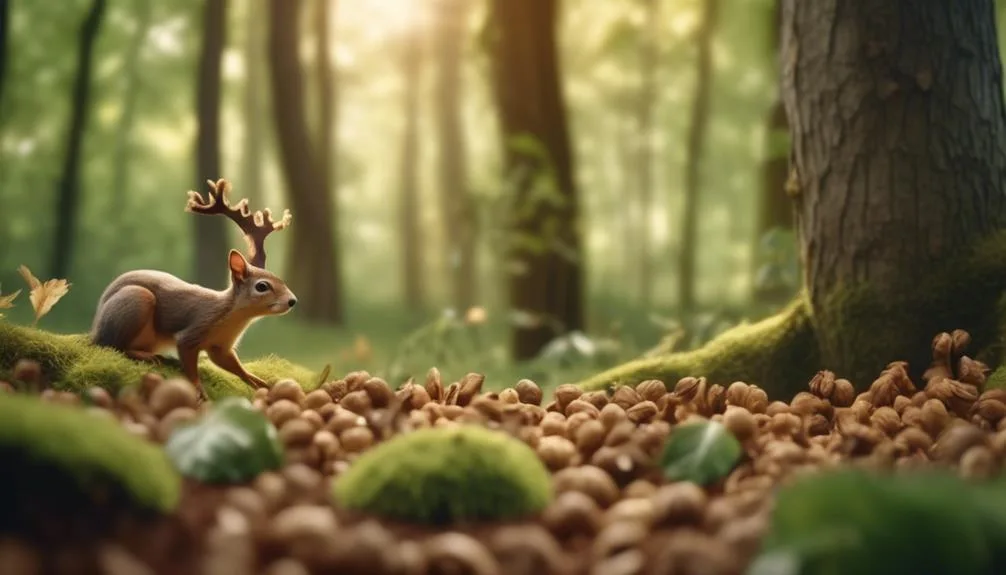Walnut trees are crucial for the wildlife that depends on them. Their leafy canopies and fallen nuts provide vital support for a variety of creatures.
But why are these trees so important for wildlife? Let's take a look at how walnut trees contribute to the ecosystem and help a wide range of wildlife species.
Key Takeaways
- Walnut trees provide a valuable food source and aid in the dispersal of nutrients through their nutrient-rich nuts, benefiting wildlife such as squirrels, woodpeckers, and blue jays.
- Walnut trees offer shelter and nesting sites for various bird species, squirrels, raccoons, and bats, providing safe spaces for wildlife to raise their young and seek refuge.
- Walnut trees support biodiversity by creating a rich wildlife habitat with their large canopy, offering shelter, food, and nesting sites for numerous species.
- Walnut trees contribute to the creation and maintenance of wildlife corridors, facilitating habitat connectivity and animal movement, which is necessary for finding mates, accessing resources, and preventing isolation and vulnerability.
Nutrient-Rich Food Source
Walnut trees provide a nutrient-rich food source for a variety of wildlife, making them an essential component of many ecosystems. The nuts, encased in hard shells, are a valuable food source for numerous animals. Squirrels are particularly fond of them, often burying them for later consumption. This behavior actually aids in the dispersal of walnut trees, as the forgotten nuts may sprout new trees.
Birds like woodpeckers and blue jays also benefit from walnut trees, feeding on the nuts and aiding in the natural propagation of these trees. The nutrient-dense nuts provide essential fats and proteins, supporting the health and energy needs of various wildlife species.
Walnut trees play a crucial role in habitat enrichment, attracting and sustaining a diverse range of animals through their provision of nourishing food.
Shelter and Nesting Sites
As you explore the significance of walnut trees for wildlife, it becomes evident that they not only provide a nutrient-rich food source but also serve as vital shelter and nesting sites for a diverse array of animals.
The dense foliage and sturdy branches of walnut trees offer excellent shelter from predators and harsh weather conditions for various bird species, such as woodpeckers, owls, and nuthatches.
Additionally, the unique bark patterns and crevices in walnut trees provide ideal nesting sites for squirrels, raccoons, and even some species of bats.
These trees play a crucial role in habitat enhancement, creating safe spaces for wildlife to raise their young and seek refuge.
Biodiversity Support
How do walnut trees contribute to the support of biodiversity in their ecosystems?
Walnut trees play a crucial role in supporting biodiversity by providing a rich wildlife habitat. The large canopy of walnut trees offers shelter, food, and nesting sites for numerous species, including birds, squirrels, and insects. This diverse array of wildlife relies on the walnut tree for survival, creating a thriving ecosystem.
Additionally, the fallen leaves, twigs, and nuts from walnut trees contribute to the rich organic matter on the forest floor, supporting a variety of decomposers and soil organisms. The presence of walnut trees enhances species diversity within the ecosystem, promoting a healthy balance and interdependence among different plants and animals.
As a result, the conservation and proliferation of walnut trees are essential for maintaining and enriching the overall biodiversity of their habitats.
Wildlife Corridors
Supporting a diverse array of wildlife, the walnut trees' role extends beyond providing shelter, food, and nesting sites. They also contribute to the creation and maintenance of vital wildlife corridors within their ecosystems.
Wildlife corridors, also known as habitat corridors or greenways, are essential for habitat connectivity and wildlife movement. They facilitate landscape connectivity, enabling animal migration and the exchange of genetic material between populations.
Walnut trees play a crucial role in creating these corridors by providing cover and food sources that support the movement of various species. These corridors are like lifelines, allowing animals to travel between different habitats, find mates, and access new resources.
Without them, wildlife populations can become isolated, leading to reduced genetic diversity and increased vulnerability to environmental changes.
Ecosystem Contribution
Contribute to the overall health and balance of the ecosystem, walnut trees play a vital role in providing essential resources for a wide variety of plant and animal species. Their extensive root systems aid in erosion prevention, anchoring soil to prevent runoff and landslides.
Furthermore, walnut trees contribute to water filtration, absorbing excess nutrients and pollutants from the soil, thus improving water quality. These trees also play a crucial role in carbon sequestration, helping to mitigate climate change by absorbing and storing carbon dioxide from the atmosphere.
In addition to these benefits, walnut trees support habitat restoration by providing food and shelter for numerous wildlife species, fostering biodiversity and ecological resilience.
Conclusion
In appreciating and protecting walnut trees, we not only value their beauty and resources for humans but also recognize their vital role in supporting wildlife.
These trees provide essential food, shelter, and nesting sites, contributing to biodiversity and healthy ecosystems.
Let's continue to cherish and safeguard these important trees for the benefit of all the creatures that depend on them.

